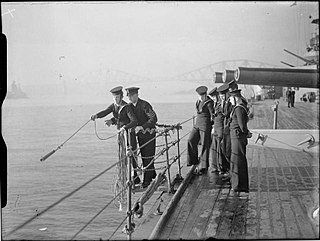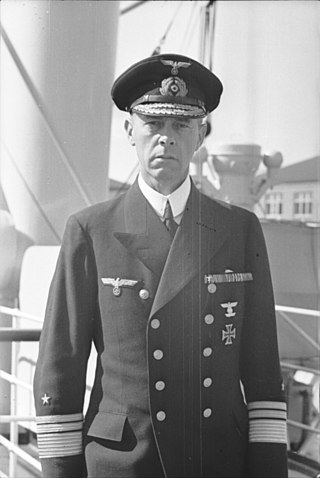The examples and perspective in this article deal primarily with the United Kingdom and Canada and do not represent a worldwide view of the subject.(July 2011) |
Able seaman is a military rank used in naval forces.
The examples and perspective in this article deal primarily with the United Kingdom and Canada and do not represent a worldwide view of the subject.(July 2011) |
Able seaman is a military rank used in naval forces.

In 1653 the Royal Navy introduced a new pay scale as part of reforms following defeat in the Battle of Dungeness the previous year. Included in these reforms were, for the first time, separate pay scales for more experienced seamen that distinguished between an ordinary seaman and an able seaman. The higher ranked able seaman was required to be competent in steering, use the lead and working aloft, [1] and received about 25% higher pay than an ordinary seaman.
In the middle of the 18th century the term "able seaman" (abbreviated AB) referred to a seaman with more than two years experience at sea and considered "well acquainted with his duty". [2] Seamen with less experience are referred to as landsmen (for the first year at sea) or ordinary seamen (for the second).
In time of war (such as the Seven Years' War or the Napoleonic Wars), with many more warships in service, the navy, merchant marine, and privateers competed ferociously for the limited pool of able seamen, leading to the unpopular use of impressment by the Royal Navy to keep its ships manned. In peacetime, with fewer active warships, there was usually a surplus of unemployed able seamen willing to work in the navy. As late as the Napoleonic Wars, the Royal Navy's practice of stopping American ships to press American sailors into involuntary service was one of the main factors leading to the War of 1812 with the United States.

In the Royal Canadian Navy, sailor second class (previously able seaman until August 2020) is the second-lowest of the non-commissioned member ranks, ranking above sailor third class and below sailor first class. Sailors second class wear a single gold chevron, point down, as an insignia of rank; it is worn on the upper part of both sleeves of the service dress tunic, and on slip-ons on both shoulders on other uniforms.
In all trades, the rank is awarded on completion of 30 months of service, by which time all initial training is completed. Consequently, it is sometimes said that promotion to the rank of sailor second class means the recipient has lost their 'best excuse', on the theory that sailors third class are generally assumed to know nothing.
Sailor second class is the equivalent rank to private (trained), or simply private, in the Army and Air Force. In French the rank is called matelot de 2e classe.
In August 2020, the Royal Canadian Navy replaced the term seaman with the gender-neutral term sailor. Able seamen are now referred to as "sailor second class". [3] [4] [5]

In the Royal Australian Navy, able seaman (AB) is the second-lowest of the non-commissioned member ranks, ranking above seaman and below leading seaman.
Able seaman is the equivalent rank to Leading aircraftman, in the Royal Australian Air Force and Private Proficient in the Australian Army. It is not equivalent to Lance Corporal which is rated as E4, not E3 like the ranks of Able Seaman and Leading Aircraftsman.
Able Seamen with additional skills are denoted by modifications to the "AB" rank; for example photography skills which are acknowledged in the title Able Seaman Imagery Specialist, or ABIS. [6]
A private is a soldier, usually with the lowest rank in many armies. Soldiers with the rank of private may be conscripts or they may be professional (career) soldiers.

A non-commissioned officer (NCO) is a military officer who does not hold a commission. Non-commissioned officers usually earn their position of authority by promotion through the enlisted ranks. In contrast, commissioned officers usually enter directly from a military academy, officer training corps (OTC) or reserve officer training corps (ROTC), or officer candidate school (OCS) or officer training school (OTS), after receiving a post-secondary degree.

The Royal Canadian Navy is the naval force of Canada. The navy is one of three environmental commands within the Canadian Armed Forces. As of February 2024, the RCN operates 12 Halifax-class frigates, 12 Kingston-class coastal defence vessels, 4 Victoria-class submarines, 2 Harry DeWolf-class offshore patrol vessels, 8 Orca-class patrol vessels, and several auxiliary vessels. The RCN consists of 8,400 Regular Force and 4,100 Primary Reserve sailors, supported by 3,800 civilians. Vice-Admiral Angus Topshee is the commander of the Royal Canadian Navy and chief of the Naval Staff.
A midshipman is an officer of the lowest rank in the Royal Navy, United States Navy, and many Commonwealth navies. Commonwealth countries which use the rank include Canada, Australia, Bangladesh, Namibia, New Zealand, South Africa, India, Pakistan, Singapore, Sri Lanka, and Kenya.

In a military navy, a rate or rating, and sometimes known as a bluejacket in the United States, is a junior enlisted sailor who is below the military rank of warrant officer. They are not a commissioned officer. Depending on the country and navy that uses it, the exact term and the range of ranks that it refers to may vary.

Impressment, colloquially "the press" or the "press gang", is the forced conscription of men into a military force, especially a naval force, via intimidation and physical coercion, conducted by an organized group. European navies of several nations used forced recruitment by various means. The large size of the British Royal Navy in the Age of Sail meant impressment was most commonly associated with Great Britain and Ireland. It was used by the Royal Navy in wartime, beginning in 1664 and during the 18th and early 19th centuries as a means of crewing warships, although legal sanction for the practice can be traced back to the time of Edward I of England. The Royal Navy impressed many merchant sailors, as well as some sailors from other, mostly European, nations. People liable to impressment were "eligible men of seafaring habits between the ages of 18 and 55 years". Non-seamen were sometimes impressed as well, though rarely. In addition to the Royal Navy's use of impressment, the British Army also experimented with impressment from 1778 to 1780.
A petty officer (PO) is a non-commissioned officer in many navies. Often they may be superior to a seaman, and subordinate to more senior non-commissioned officers, such as chief petty officers.
Seaman apprentice is the second lowest enlisted rate in the U.S. Navy, U.S. Coast Guard, and the U.S. Naval Sea Cadet Corps just above seaman recruit and below seaman; this rank was formerly known as seaman second class.

Seaman is a military rank used in many navies around the world. It is considered a junior enlisted rank and, depending on the navy, it may be a single rank on its own or a name shared by several similarly junior ranks.
Prize money refers in particular to naval prize money, usually arising in naval warfare, but also in other circumstances. It was a monetary reward paid in accordance with the prize law of a belligerent state to the crew of a ship belonging to the state, either a warship of its navy or a privateer vessel commissioned by the state. Prize money was most frequently awarded for the capture of enemy ships or of cargoes belonging to an enemy in time of war, either arrested in port at the outbreak of war or captured during the war in international waters or other waters not the territorial waters of a neutral state. Goods carried in neutral ships that are classed as contraband, being shipped to enemy-controlled territory and liable to be useful to it for making war, were also liable to be taken as prizes, but non-contraband goods belonging to neutrals were not. Claims for the award of prize money were usually heard in a prize court, which had to adjudicate the claim and condemn the prize before any distribution of cash or goods could be made to the captors.
Leading seaman is a junior non-commissioned rank or rate in navies, particularly those of the Commonwealth. When it is used by NATO nations, leading seaman has the rank code of OR-4. It is often equivalent to the army and air force rank of corporal and some navies use corporal rather than leading seaman.
The Indian Navy (IN), the naval component of the Indian Armed Forces follows a certain hierarchy of rank designations and insignia derived from the erstwhile Royal Indian Navy (RIN).
Master sailor, formerly Master seaman, or matelot-chef (matc) in French, is a non-commissioned member rank of the Royal Canadian Navy, which is between sailor first class and petty officer 2nd class. Technically, the rank is actually an appointment, with appointees holding the rank of sailor first class. If demoted, a master sailor will become an sailor second class or sailor first class depending on seniority. However, the process to be appointed is very similar to that of a promotion, and holding the appointment of master sailor is a prerequisite to promotion to PO2.
Before Unification as the Canadian Armed Forces in 1968, the Canadian military had three distinct services: the Royal Canadian Navy, the Royal Canadian Air Force, and the Canadian Army. All three services had a Regular (full-time) component and a reserve (part-time) component. The rank structure for these services were based on the services of the British military, the Royal Navy, the Royal Air Force, and the British Army. The change to a "Canadian" rank structure meant that many of the traditional (British) rank titles and insignia were removed or changed.

A boy seaman is a boy who serves as seaman or is trained for such service.

This is a list of Royal Navy ratings rank insignia.
Ordinary seaman is a military rank used in naval forces.

The Kriegsmarine was the navy of Nazi Germany prior to and during World War II. Kriegsmarine uniform design followed that of the preexisting Reichsmarine, itself based on that of the First World War Kaiserliche Marine. Kriegsmarine styles of uniform and insignia had many features in common with those of other European navies, all derived from the British Royal Navy of the 19th century, such as officers' frock coats, sleeve braid, and the "sailor suit" uniform for enlisted personnel and petty officers.

Royal Navy ranks, rates, and uniforms of the 18th and 19th centuries were the original effort of the Royal Navy to create standardized rank and insignia system for use both at shore and at sea.

A sailor, seaman, mariner, or seafarer is a person who works aboard a watercraft as part of its crew, and may work in any one of a number of different fields that are related to the operation and maintenance of a ship.